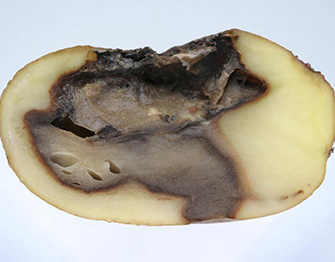Please click here to access the main AHDB website and other sectors.
- Home
- Knowledge library
- Potato Disease Identification
Potato Disease Identification
There are a number of diseases to be aware of that could affect your potatoes. This page provides a gallery of visual symptoms to help you identify what disease your crop may have developed.
Each disease listed below features a link to further information on the symptoms, conditions and controls. The disease and defects poster is also a useful visual summary of what may be affecting your potatoes. Download the pdf using the link below.
Download the potato diseases and defects poster
Potato disease gallery
Browse the images below to identify which disease may be affecting your potatoes. Each disease features a link to further information on the symptoms, causes and controls.
Alternaria
Alternaria, also known as early blight, is a mainly soil-borne fungal pathogen that affects potato crops. Diagnosis can be problematic as symptoms can be mistaken for nutrient deficiency or Verticillium wilt.
Alternaria causes lesions on the leaves which often have a target spot appearance of concentric rings. These usually (but not always) appear a few weeks after emergence and start as very small black or brown spots on lower leaves which then coalesce.
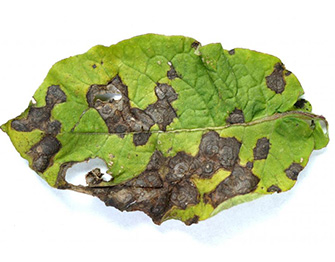
Black dot
Black dot is caused by the fungus Colletotrichum coccodes and although a mild disease it is one of the most problematic blemish diseases of washed, pre-packed potatoes.
It takes its name from the tiny jet black microsclerotia that are just visible to the naked eye both on the blemish and on stem and stolen lesions late in the season.
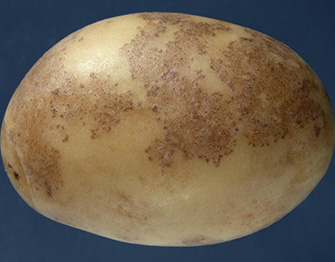
Blackleg and bacterial soft rot
The bacteria Dickeya and Pectobacterium species cause tuber soft rots.
Pectobacterium atrosepticum has traditionally been considered the main cause of blackleg in the UK. Certain Dickeya species can cause wilts and stem rots in warmer seasons, especially when the temperature rises above 25ºC.
Symptoms of soft rot typically include soft, wet, cream-colored tissues. Diseased tissue is sharply demarcated from healthy tissue and sometimes has darker margins.
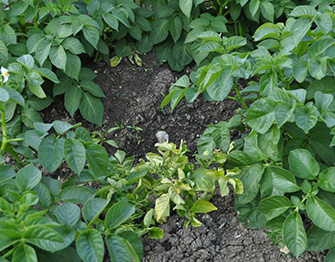
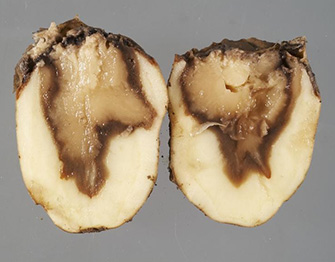
Black scurf and stem canker
Rhizoctonia solani is a fungus causing stem canker, damping off, black scurf, skin netting and tuber growth distortions.
Black scurf can be soil and seed borne and survives a long time in soil and on volunteers or crop debris. There is no significant proliferation during storage.
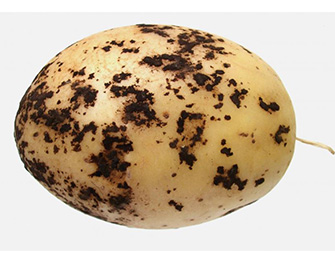
Dry rot
Dry rot is the most important fungal rot of potatoes, affecting around 1% of tubers in Great Britain.
It is mainly caused by a group of four Fusarium species, particularly in warm, sandy soils.
Generally, dry rots develop around an initial wound, dehydrating in concentric wrinkles and with white, fluffy mycelial growth.
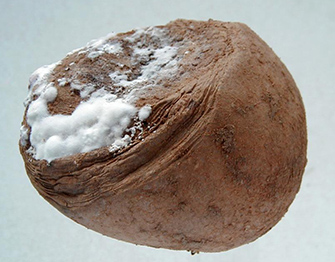
Brown rot
Notifiable disease
Potato brown rot poses a serious threat to GB potato production and vigilance is required to prevent its introduction and spread.
Several isolated cases have occurred linked to the presence of the causative bacterium (Ralstonia solanacearum) in certain watercourses and it is a notifiable disease.
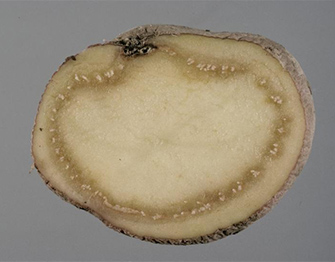
Common scab
Common scab, caused mainly by Streptomyces scabiei, is an unsightly blemish disease that can affect any crop where tubers experience a dry surface during the critical stage of three to six weeks after tuber initiation.
Consequently it can be especially problematic where irrigation is not available.
The disease has little effect on storability and does not develop in store.
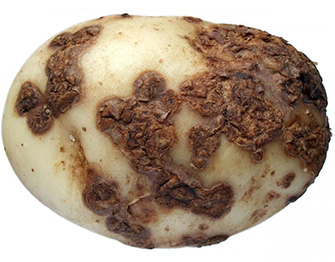
Gangrene
Gangrene is a slow-growing fungal disease of stored potatoes favoured by cool climates.
Early symptoms are small round, dark depressions that may appear dark grey to brown. These grow to resemble thumb impressions and may overlap, leaving ridges in between.
Wrinkles tend to stretch across, rather than the concentric rings expected with dry rots.
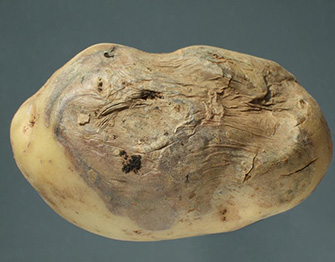
Late blight
Late blight remains the single most important potato disease in GB. It is caused by the oomycete Phytophthora infestans which can infect foliage, stems and tubers and spread prolifically on the wind.
Tuber infection symptoms are a darker brown, sometimes purplish, area on the tuber surface. The internal rot is a reddish brown, granular rot which can remain close to the surface or progress to the centre of the tuber. Development is irregular and sometimes threadlike through the tuber flesh. Late blight causes skin damage which eventually allows opportunistic bacterial soft rots to invade and flourish
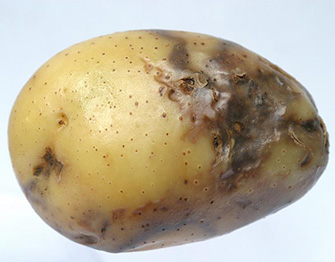
Latent and mild mosaic viruses
These viruses cause a range of foliar symptoms from none (latent) to very weak, through to a pronounced mosaic, with some distortion of the leaflets.
These viruses have an important economic impact since they affect yield and quality.
Latent crop infections provide a reservoir of inoculum that may infect adjacent crops.
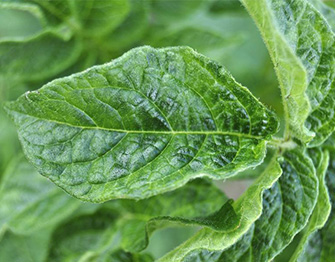
Pink rot
Pink rot can be devastating, especially in hot dry years. Tubers may appear sound at loading but breakdown can begin in a matter of weeks.
Externally the infection front has a dark edge but this is not the case on the internal cut surface. Initially the affected flesh might appear more white or light grey than the natural flesh tone but within an hour the cut surface can turn pink and later dark brown to black.
Advanced infections lead to complete tuber breakdown and secondary infections.
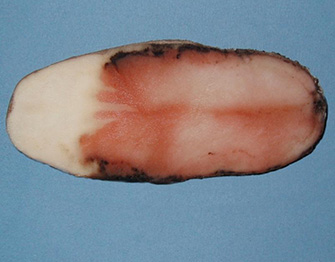
Potato Leafroll Virus (PLRV)
PLRV was once the most common virus in seed stocks. It is transmitted by aphids in a persistent manner; once an aphid acquires the virus it is infective for life.
Primary symptoms, those exhibited during the year of infection, are often slight and may be missed. A slight rolling and red/orange tinge can occur in the upper leaves.
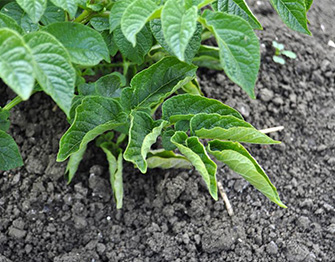
Potato Virus Y (PVY)
Depending on virus strain and potato variety, symptoms vary from mild mosaic to severe foliar necrosis to plant death.
The most obvious tuber symptom associated with potato viruses is Potato Tuber Necrotic Ring Disease associated with infection of susceptible varieties with PVYNTN type isolates.
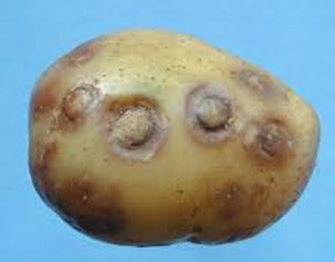
Powdery scab
Powdery scab is a fungal blemish disease. Symptoms can be confused with Common scab. Powdery scab lesions are more uniform in shape and are generally small, round eruptions through the skin, which mostly remain discrete. The 'powder' is comprised of spore balls that are released into the soil and can survive up to ten years. These release motile zoospores that infect root hairs.
Powdery scab is also a vector of Potato Mop Top Virus, a cause of spraing.
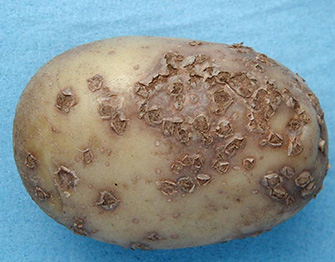
Ring rot
Notifiable disease
Ring rot is caused by the bacterium Clavibacter michiganensis subsp. sepedonicus.
The disease is favoured by cooler climates. Already established in northern and Eastern Europe, the disease could readily establish under UK conditions. Symptoms are much more likely to be seen in tubers and are somewhat similar to those of brown rot.
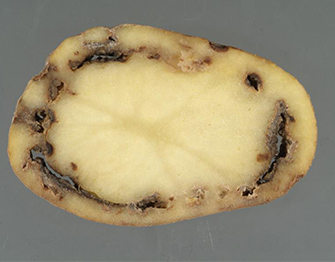
Silver scurf
Silver scurf is a blemish disease caused by the fungus Helminthosporium solani.
Infection can originate from seed tubers, the soil or from spores remaining in store. Symptoms are normally present at harvest but the disease develops in store.
Affected skin is weakened, prone to scuffing and can wrinkle due to moisture loss.
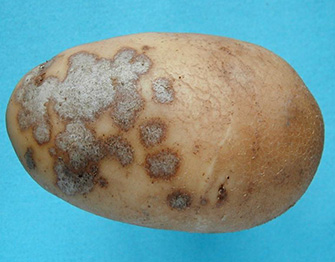
Skin spot
Skin spot is a blemish disease caused by the fungus Polyscytalum pustulans. Symptoms develop after approximately two months of storage, when the infected tissue begins to show spots on some varieties.
The blemish reduces market value, and even processing crops might require extra peeling to remove well developed symptoms.
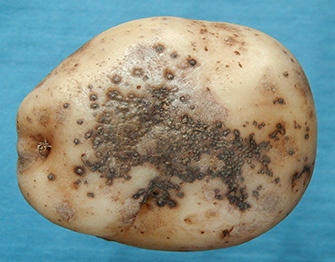
Potato Mop Top Virus (PMTV)
PMTV is one of two viruses that causes spraing in potato.
Infections are commonly associated with tuber internal blemishing (see also TRV).
This is a significant cause of rejections of both ware and processing crops. Symptoms do not increase during storage.
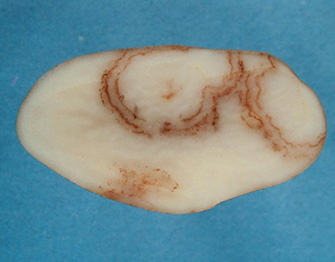
Tobacco Rattle Virus (TRV)
TRV is one of two viruses causing spraing in potato which is most commonly associated with tuber internal blemishing (see also PMTV).
These defects are significant and cause rejections of both ware and processing crops. Symptoms do not increase during storage.
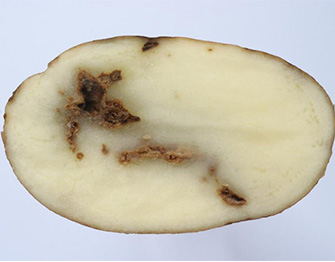
Tobacco Necrosis Virus (TNV)
TNV is a rare tuber blemish disease with no haulm symptoms. The disease is also known as ABC disease named after three symptom categories first described in the Netherlands.
- A = dark brown, raised patches;
- B = dark sunken lesions, sometimes in rings/horseshoes;
- C = light brown, cracked patches.
Any combination of these symptoms may occur but look for dark coalescing rings, very dark patches, and mild light tan patches.
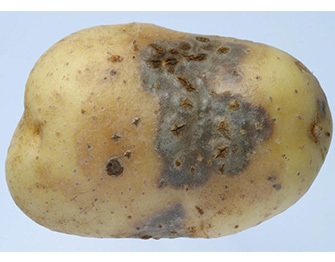
Verticillium wilt
Verticillium wilt is a fungal disease of the vascular tissue of potato and most commercial cultivars are susceptible.
The disease is often seen as scattered patches in a field and can result in stunting, premature plant senescence and ultimately a reduced yield.
Plants may lose turgor and wilt, especially on hot sunny days.
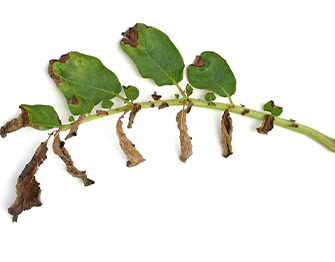
Violet root rot
Violet root rot is most commonly seen as a blemish on tubers although roots can be affected.
Affected tubers can be covered in a fine network of purple mycelia that can join to form a net of thickened strands. These will be lost on washing but the purple brown microsclerotia will remain in affected patches.
The margins of these patches are likely to have ragged edges where skin has been undermined. This skin damage may lead to soft rotting by secondary infection.
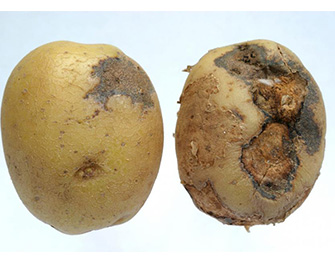
Wart disease
Notifiable disease
Tubers, stolons and occasionally leaf stalks are affected by this disease but not roots.
Tubers may bear cauliflower-like tumours at the eyes, or the whole tuber may become a shapeless, warted mass.
This disease may progress in store even from minute warts not seen at lifting.
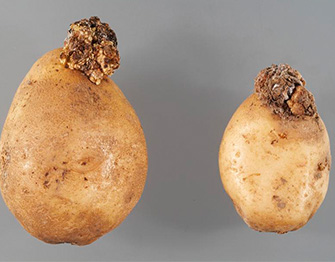
Watery wound rot
Watery wound rot or leak is a vigorous rot of lifted tubers caused by a fungus. It is widespread and common but only occasionally serious in a crop.
Affected flesh can be discoloured grey through to brown with a dark margin. It is moist and quickly liquefies.
A fresh cut can smell alcoholic or, if more advanced, fishy.
